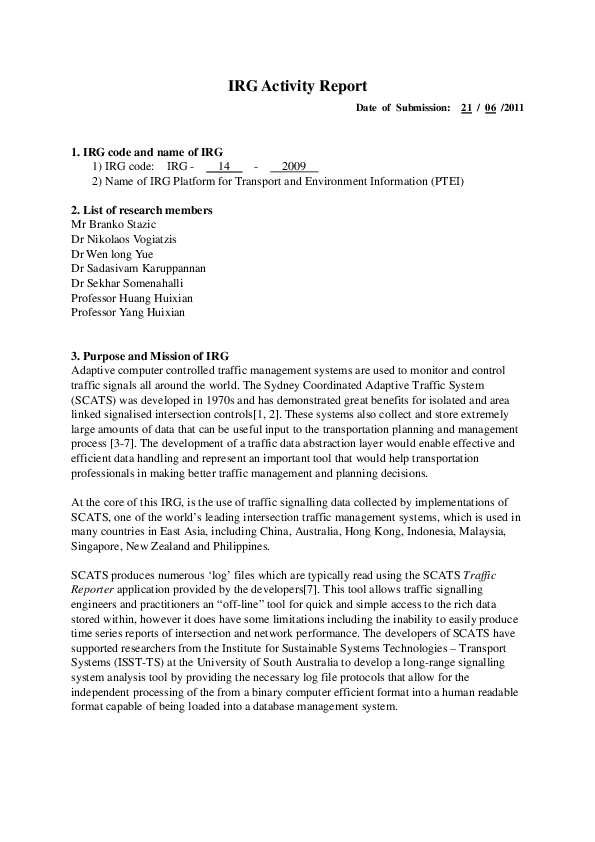Academia.edu no longer supports Internet Explorer.
To browse Academia.edu and the wider internet faster and more securely, please take a few seconds to upgrade your browser.
IRG Activity Report
IRG Activity Report
Adaptive computer controlled traffic management systems are used to monitor and control traffic signals all around the world. The Sydney Coordinated Adaptive Traffic System (SCATS) was developed in 1970s and has demonstrated great benefits for isolated and area linked signalised intersection controls [1, 2]. These systems also collect and store extremely large amounts of data that can be useful input to the transportation planning and management process [3-7]. The development of a traffic data abstraction layer would ...
Related Papers
The 3rd International Conference on Vehicle Navigation and Information Systems,
A Novel Architecture For Traffic Control1992 •
Having spent many hours battling congestion and growing frustrated with ‘new’ traffic control methods which never seemed to work, the researcher grasped the opportunity to investigate potential new approaches to the issue of transport and congestion when the opportunity arose.
arXiv: Signal Processing
Advanced Traffic Management Systems: An Overview and A Development Strategy2018 •
Nowadays the problem of traffic congestion is known as the main cause of air pollution in the cities of the world. Urban traffic engineers and managers have proposed three general approaches to dealing with this phenomenon. The first approach expands the capacity of the urban traffic network (UTN). This approach cannot be implemented in many urban areas due to urban density and traffic volume. The second approach can be called the traffic assignment. In this approach, through software applications or information boards, network managers are informed about the users' status in the network and offer the best route to them. Finally, the third approach involves optimizing the capacity of the UTN. This approach tries to control the traffic actuators in order to create the maximum capacity for network users. Therefore, it can be said that the advanced traffic management systems (ATMS) are based on four main sections. These four sections include traffic information, traffic assignment,...
Journal of Transportation Technologies
Performance Evaluation of Intelligent Adaptive Traffic Control Systems: A Case Study2012 •
IEEE Transactions on Control Systems Technology
Roadway traffic control software1994 •
Abstract-Roadway traffic control is an important practical example of real time control applications, but effective roadway control is hampered by a variety of organizational, financial and technical considerations. One major hurdle is the current reliance on outmoded field ...
Advances in Civil Engineering
Development and Evaluation of a Control System for Regional Traffic Management2011 •
Traffic congestion is a worsening problem in metropolitan areas which will require integrated regional traffic control systems to improve traffic conditions. This paper presents a regional traffic control system which can detect incident conditions and provide integrated traffic management during nonrecurrent congestion events. The system combines advanced artificial intelligence techniques with a traffic performance model based on HCM equations. Preliminary evaluation of the control system using traffic microsimulation demonstrates that it has the potential to improve system conditions during traffic incidents. In addition, several enhancements were identified which will make the system more robust in a real traffic control setting. An assessment of the control system elements indicates that there are no substantial technical barriers in implementing this system in a large traffic network.
RELATED PAPERS
2017 •
Clinical Pharmacokinectics
Pharmacokinetics and Target Attainment of Antibiotics in Critically Ill Children: A Systematic Review of Current Literature2019 •
2003 •
Finding Meaning: Essays on Philosophy, Nihilism and the Death of God. Edited by Steven DeLay. Eugene Oregon: Cascade, 2023.
Teleology, Tragedy, and the Death of God2023 •
Drug and Alcohol Dependence
Ineligible for most protocols: What differentiates drug users?2015 •
Journal of Strength & Conditioning Research
Countermovement Jump and Momentum Generation Associations to Fastball Velocity Performance Among Division I Collegiate Pitchers
 Sekhar Somenahalli
Sekhar Somenahalli